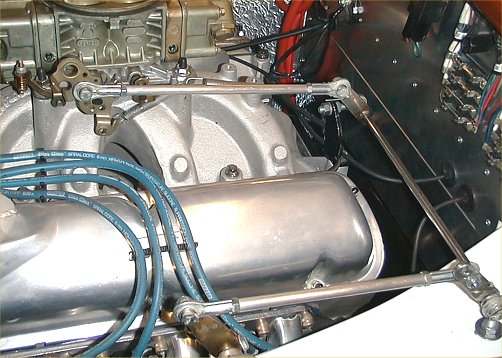Setting up the 4bbl carburetor linkage
- Wire the carburetor linkage fully open.
- Install the cross-shaft onto the engine, keeping the shaft as parallel to the firewall as possible and fairly horizontal.
- Install the link from the carb to the cross-shaft, adjusting the length so that the cross-shaft bellcrank is angled about 30 degrees toward the firewall.
- Adjust the bellcrank on the pedal shaft so that it is angled back toward the firewall about 20 degrees when the pedal is bottomed out on the floor.
- Install the link from the pedal to the cross-shaft so that the pedal is about 1/2" from hitting the floor.
- Remove the wire holding the carburetor linkage and check whether the pedal is at a convenient height. If it is too high, change the link footbox link to a lower hole on the cross-shaft. If it is too low, change the engine link to a lower hole on the cross-shaft.
- Install the return springs and check whether you're still getting full throttle.
- Tighten all bolts and jam nuts, check for interference, and grease all the pivot points.
- If you want the "smooth look" shown below, cut some 5/16" brake line to length to cover the middle section of the threaded rods.
The engine at right, with a low-rise manifold and 550 cfm carb uses all the top holes in the footbox bellcrank and linkage cross-shaft.
Note the dual return springs on both setups: One from the bottom of the carb to the manifold, one from the manifold to the cross-shaft bellcrank.

